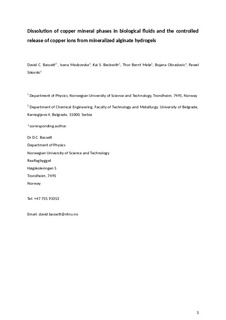| dc.contributor.author | Bassett, David | |
| dc.contributor.author | Madzovska, Ivana | |
| dc.contributor.author | Beckwith, Kai Sandvold | |
| dc.contributor.author | Melø, Thor Bernt | |
| dc.contributor.author | Sikorski, Pawel | |
| dc.contributor.author | Obradovic, Bojana | |
| dc.date.accessioned | 2017-08-31T07:56:44Z | |
| dc.date.available | 2017-08-31T07:56:44Z | |
| dc.date.created | 2015-01-19T14:35:08Z | |
| dc.date.issued | 2015 | |
| dc.identifier.citation | Biomedical Materials. 2015, 10 (1), . | nb_NO |
| dc.identifier.issn | 1748-6041 | |
| dc.identifier.uri | http://hdl.handle.net/11250/2452488 | |
| dc.description.abstract | Here we investigate the dissolution behaviour of copper minerals contained within biocompatible alginate hydrogels. Copper has a number of biological effects and has most recently been evaluated as an alternative to expensive and controversial growth factors for applications in tissue engineering. Precise control and sustained release of copper ions are important due to a narrow therapeutic window of this potentially toxic ion, and alginate would appear to be a good material of choice for this purpose. We found that aqueously insoluble copper minerals could be precipitated during gelling within or mixed into alginate hydrogels in the form of microbeads prior to gelling to serve as depots of copper. These minerals were found to be soluble in a variety of biological fluids relevant to in vitro and in vivo investigations, and the alginate carrier served as a barrier to diffusion of these ions and therefore offered control over the rate and duration of release (Cu2+ release rates observed between 10–750 µMol g−1 h−1 and duration for up to 32 d). Copper mineral and copper mineralized alginate microbeads were characterized using powder x-ray diffraction, FTIR, thermogravimetric analysis and scanning electron microscopy. Dissolution kinetics were studied based on measurements of copper ion concentrations using colourimetric methods. In addition we characterized the complexes formed between released copper ions and biological fluids by electron paramagnetic spectroscopy which offers an insight into the behaviour of these materials in the body. | nb_NO |
| dc.language.iso | eng | nb_NO |
| dc.publisher | IOP Publishing | nb_NO |
| dc.title | Dissolution of copper mineral phases in biological fluids and the controlled release of copper ions from mineralized alginate hydrogels | nb_NO |
| dc.type | Journal article | nb_NO |
| dc.type | Peer reviewed | nb_NO |
| dc.description.version | acceptedVersion | nb_NO |
| dc.source.pagenumber | 12 | nb_NO |
| dc.source.volume | 10 | nb_NO |
| dc.source.journal | Biomedical Materials | nb_NO |
| dc.source.issue | 1 | nb_NO |
| dc.identifier.doi | 10.1088/1748-6041/10/1/015006 | |
| dc.identifier.cristin | 1201200 | |
| dc.relation.project | Norges forskningsråd: 214607 | nb_NO |
| dc.description.localcode | This is the authors' accepted and refereed manuscript to the article. | nb_NO |
| cristin.unitcode | 194,66,20,0 | |
| cristin.unitname | Institutt for fysikk | |
| cristin.ispublished | true | |
| cristin.fulltext | postprint | |
| cristin.qualitycode | 1 | |
